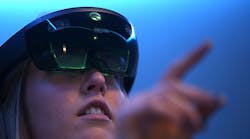Microsoft Corp. unveiled a new platform based on its Windows 10 software catering to virtual and augmented reality technology developed by other companies.
Windows Holographic will enable rival headsets, such as HTC Corp.’s virtual reality device Vive, to interact with Microsoft’s own Hololens as well as each other, executive vice president Terry Myerson said at the Computex trade show in Taipei on Wednesday. Partners will be encouraged to build personal computers, displays and accessories for the platform to develop experiences mixing the reality technologies.
Microsoft has been investing in Hololens to build practical applications for its augmented reality headset. Last year, it teamed with Volvo Car Group to bring the technology to automotive showrooms. The company has started shipping developer kits costing $3,000 to customers so they can then develop applications for the headset.
“We began shipping Microsoft Hololens in March and customers across industries are embracing the potential of mixed reality already,” Myerson said in a blog post. “I can’t wait to see what our partners do with Windows Holographic.”
Attracting new customers will be critical to securing broad adoption for Hololens. Among those partnering with Microsoft on Windows Holographic are Intel Corp., Qualcomm Inc., HTC, Acer Inc. and Lenovo Group Ltd., it said.
Opening up the platform gives partners the chance to improve on rival products and monetize their content, said Nick Parker, corporate vice president of Microsoft’s Original Equipment Manufacturer division.
“We bring a store,” he said. “What we’ll see is partners start to take their capabilities, how they can bring it together with other partners to create a unique device that may be independent.”
Microsoft’s Windows 10 software is already running on more than 300 million active devices. The company said over 80 million virtual reality devices are expected by 2020.
“However, many of today’s devices and experiences do not work with each other, provide different user interfaces, interaction models, input methods, peripherals, and content,” Myerson said “And most virtual reality experiences can’t mix real people, objects, and environments into the virtual world, making creation and collaboration difficult.”
Microsoft will unveil further details of the platform at the winHEC developers’ conference in the fall, Myerson said in his blog post.
In other Microsoft news, Chinese smartphone maker Xiaomi has purchased close to 1,500 of its patents, covering wireless communications, video, cloud and other multimedia tech. Xiaomi, which sold more than 70 million handsets last year, will pre-install Microsoft Office and Skype on its Android phones and tablets.
By David Ramli



